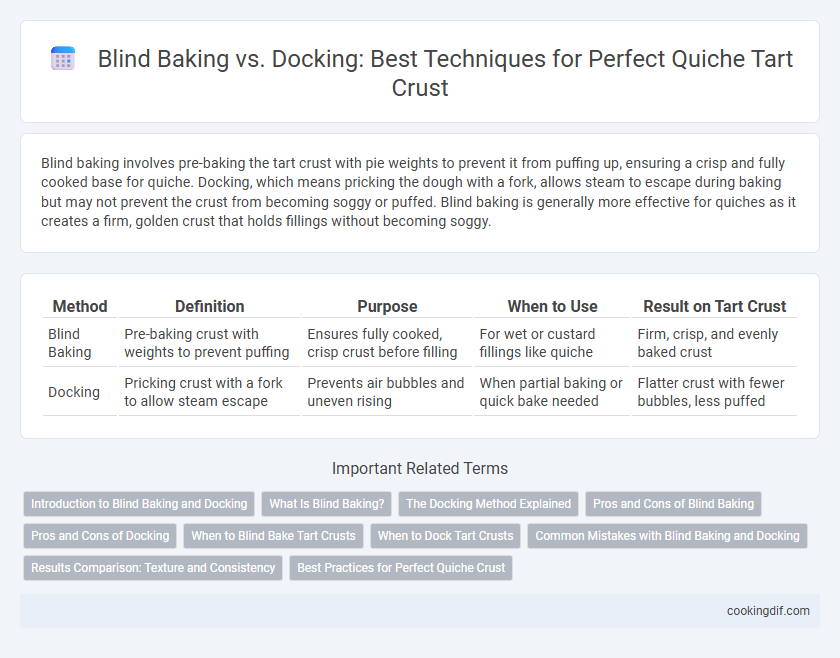Blind baking involves pre-baking the tart crust with pie weights to prevent it from puffing up, ensuring a crisp and fully cooked base for quiche. Docking, which means pricking the dough with a fork, allows steam to escape during baking but may not prevent the crust from becoming soggy or puffed. Blind baking is generally more effective for quiches as it creates a firm, golden crust that holds fillings without becoming soggy.
Table of Comparison
| Method | Definition | Purpose | When to Use | Result on Tart Crust |
|---|---|---|---|---|
| Blind Baking | Pre-baking crust with weights to prevent puffing | Ensures fully cooked, crisp crust before filling | For wet or custard fillings like quiche | Firm, crisp, and evenly baked crust |
| Docking | Pricking crust with a fork to allow steam escape | Prevents air bubbles and uneven rising | When partial baking or quick bake needed | Flatter crust with fewer bubbles, less puffed |
Introduction to Blind Baking and Docking
Blind baking involves pre-baking the tart crust to prevent sogginess when filled with wet ingredients, essential for quiche preparation. Docking refers to pricking the crust with a fork to allow steam to escape, reducing puffing during baking. Both techniques ensure a crisp, evenly cooked crust, improving quiche texture and flavor.
What Is Blind Baking?
Blind baking is the process of pre-baking a tart crust before adding the quiche filling to prevent sogginess and ensure a crisp texture. This method involves lining the crust with parchment paper or foil and filling it with pie weights or dried beans to maintain its shape during baking. Blind baking is essential for quiche crusts, especially those with liquid fillings, as it creates a firm, flaky base that holds the filling without becoming soggy.
The Docking Method Explained
Docking is a technique that involves piercing the tart crust with a fork to create small holes, allowing steam to escape during baking and preventing the formation of air bubbles. This method ensures an evenly baked crust with a crisp texture, ideal for quiches that require a tender yet firm base. Unlike blind baking, docking avoids the need for pie weights, simplifying the process while maintaining crust integrity.
Pros and Cons of Blind Baking
Blind baking a tart crust ensures a crisp, fully cooked base, preventing sogginess especially in wet fillings like quiche. It can add extra time and effort, requiring pie weights or beans to avoid puffing, and sometimes leads to over-browning or drying out if not closely monitored. However, blind baking offers superior crust texture and structural integrity compared to docking, which mainly prevents bubbling but doesn't guarantee doneness or firmness.
Pros and Cons of Docking
Docking tart crust involves piercing the dough with a fork to create small holes, allowing steam to escape during baking, which helps prevent bubbling and uneven rising. This technique promotes an even, flat surface ideal for quiche fillings but may produce a less tender crust compared to blind baking because the dough is exposed directly to heat without the weight of pie weights. Docking is quicker and simpler but can result in a slightly drier crust, lacking the crispness and structural integrity achieved through blind baking.
When to Blind Bake Tart Crusts
Blind baking tart crusts is essential when the quiche filling is liquid-based and requires a fully cooked, crisp base to prevent sogginess. This technique is crucial for recipes with custard or cream fillings that do not bake long enough to cook the crust thoroughly. Docking, which involves pricking the dough, is suitable for pre-baking crusts intended for dry fillings but does not prevent puffing or sogginess in wet-filled quiches.
When to Dock Tart Crusts
Docking tart crusts is essential when the recipe includes a wet filling that requires blind baking to prevent the crust from puffing and creating uneven surfaces. Docking creates small holes that allow steam to escape, ensuring a crisp and even texture during pre-baking. Avoid docking if the crust is lined with parchment and weighted with baking beans, as this method stabilizes the dough without piercing it.
Common Mistakes with Blind Baking and Docking
Overbaking the crust during blind baking often results in a dry, crumbly texture that can ruin the quiche's base. Docking improperly, such as piercing too deeply or unevenly, may cause uneven baking or a soggy bottom by allowing filling to seep through. Avoiding these mistakes ensures a perfectly crisp, evenly baked tart shell essential for a successful quiche.
Results Comparison: Texture and Consistency
Blind baking prevents a soggy quiche crust by fully pre-cooking the dough, resulting in a crisp and firm base that holds the filling well. Docking creates small holes that allow steam to escape, reducing puffing but often yields a slightly softer, less crisp texture compared to blind baking. For a perfectly textured quiche crust, blind baking consistently achieves a firmer, crunchier consistency, while docking is better suited for preventing large air pockets without fully baking the dough.
Best Practices for Perfect Quiche Crust
Blind baking involves pre-baking the tart crust with pie weights to prevent puffing and ensure a crisp base, essential for custard-based quiches. Docking, or pricking holes in the dough, helps steam escape but is less effective alone for preventing sogginess in wet fillings. Combining blind baking with careful docking ensures a perfectly baked, flaky crust that supports the quiche filling without becoming soggy or undercooked.
Blind baking vs docking for tart crust Infographic

 cookingdif.com
cookingdif.com